 Source: Windows Central
Source: Windows Central
Elden Ring is here, and it is a masterpiece. In our Elden Ring review, we revel in all of its open-world glory, but can’t deny its difficulty. Indeed, FromSoftware (Bloodborne, Dark Souls) veterans will almost certainly have an easier time coming into this game. We have a mountain of Elden Ring beginner’s tips you can peruse, but you’ll really need to go more in-depth if you want to overcome some of the game’s complexity.
Elden Ring is one of the best Xbox and PC games ever made, and you needn’t miss out due to its complexity. As such, here’s an in-depth explainer of the game’s melee combat elements, spoiler-free, with tips on how you should approach the game as a newcomer.
Elden Ring combat fundamentals: Staying alive
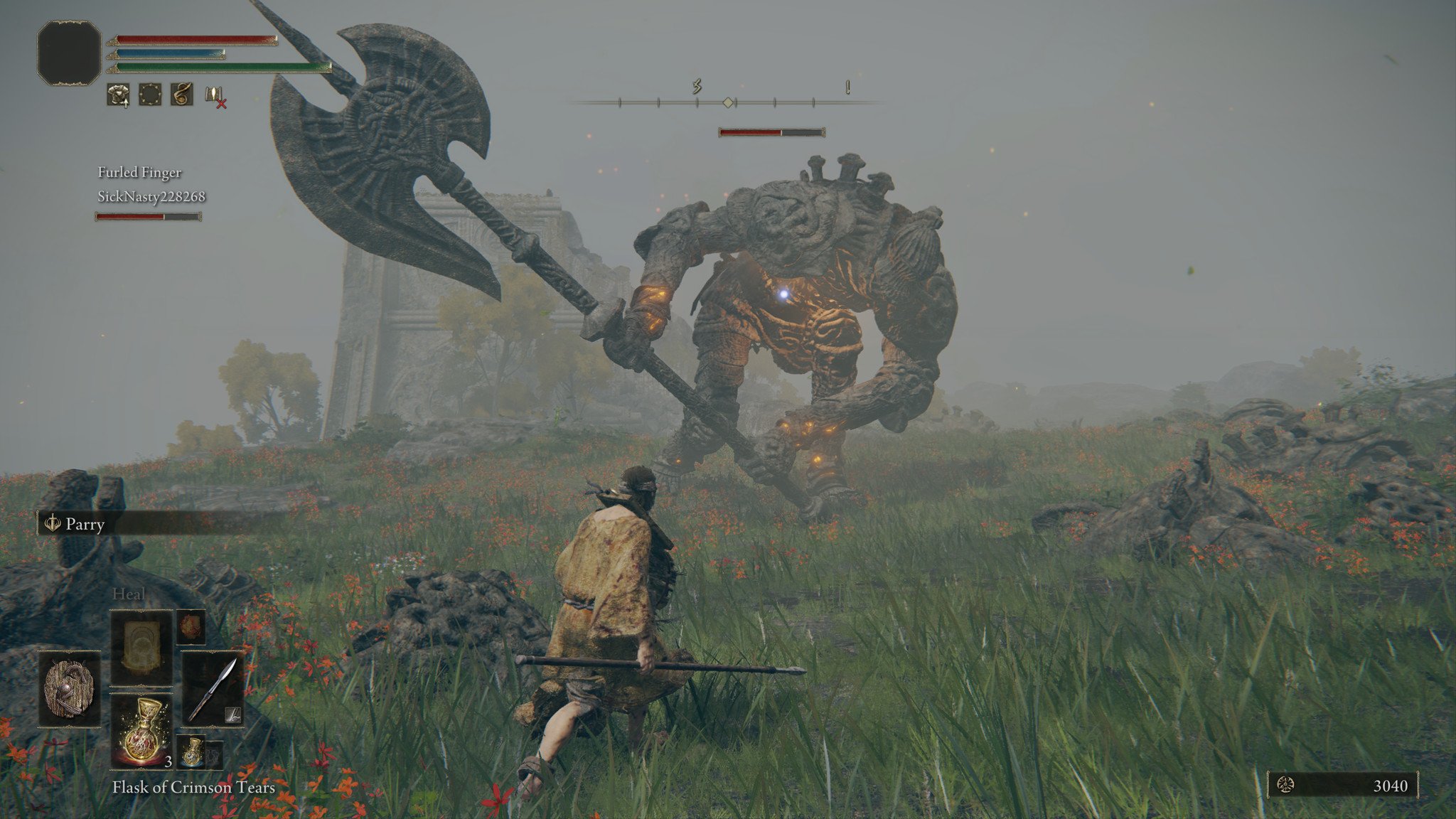
Elden Ring’s combat generally revolves around three pillars: melee, defensive play, and ranged attacks. Even if your intent is to play a dedicated wizard or archer, sometimes it may simply be optimal to step into melee every now and then, if for no reason other than to conserve your supplies of Focus Points (FP) and arrows, for example.
Managing incoming damage is very tricky and fundamental to souls games, and Elden Ring is no different.
The first thing you should really get to grips with is the relationship between FP (essentially mana) and stamina. FP is the blue bar, and stamina is the green bar. Almost all abilities consume stamina, and special abilities like magic and Ashes of War often consume FP. If you run out of FP, you can replenish it by consuming your flask of cerulean tears. If you run out of stamina, it will regen automatically if you take a second to rest. Performing actions like sprinting, dodging, blocking, and the like, will consume stamina too. So it’s good to learn when to step back from a combat situation and let it recover a bit.
Elden Ring is also filled with items that can offset some of the downsides of both FP and stamina. For example, Turtle Neck consumables increase the rate at which your stamina regens. And there are items that decrease the amount of FP used up by your spells and attacks. Paying close attention to how quickly your attacks drain your stamina is crucial to combat success. If you’re out of stamina at the wrong moment and desperately need to dodge, you may find yourself killed.
Even with heavy armor, enemies in Elden Ring often hit very hard. Managing incoming damage is very tricky and fundamental to souls games, and Elden Ring is no different.
- You can avoid all incoming damage by dodge rolling. A dodge roll gives you i-frames (invincibility frames) that are literally animation frames by which you are immune to all damage. They begin at the start of your roll, so you’ll want to time your roll so that you’re dodging a split second before an attack would otherwise hit you.
- Equipment load affects how many i-frames you get for your dodge rolls. A light load gives you the most i-frames, and fastest dodges. A medium load gives you a slightly slower dodge and less generous i-frames. Heavy loads make your rolls incredibly slow and clumsy, but can still be used in a pinch. Ideally, you’ll generally want to go no further than a medium roll. The level by which equipment load decreases your roll speed can also be mitigated by increasing your endurance when leveling up, or via talismans that increase equipment load.
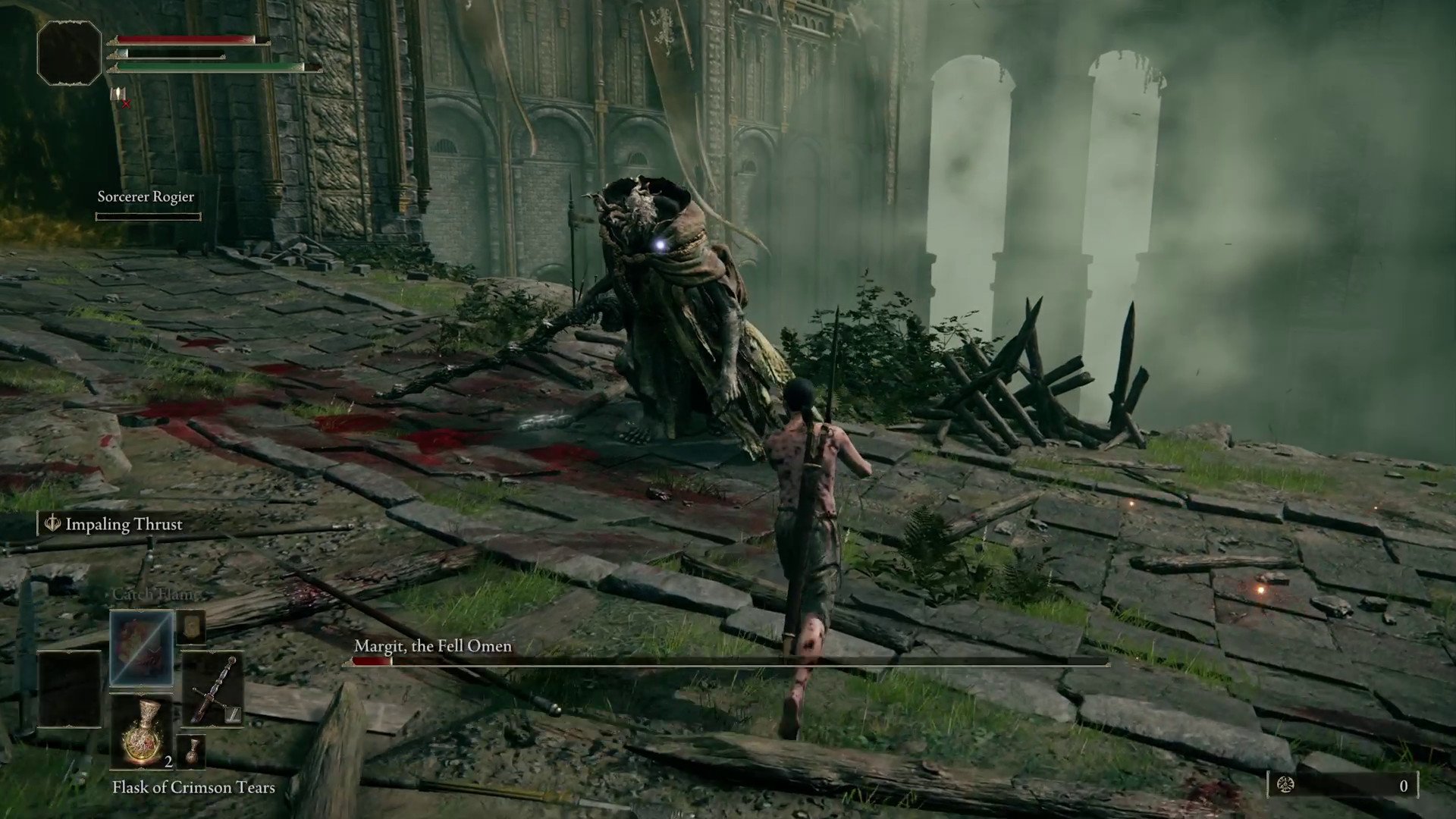
The optimal way to manage your survivability in Elden Ring is to passively invest in Vigor, which increases your hit points. If you’re an average kind of player, like me, investing every other level into HP essentially gives you more mistakes on a boss battle or combat situation. I can’t count the number of times that I’ve survived a battle with only a sliver of health left, really slamming home how much every little shred of HP helps.
Enemies will generally give you opportunities to get out of dodge and drink up. Enemies, much like yourself, often run out of stamina, leaving them hanging in recovery frames after doing a heavy attack, for example. Drinking is relatively quick, and you can increase the amount of health restored by your flasks using Sacred Tears found throughout the game’s world.
One of the best ways to survive is, ultimately, slaughter your opponent. Combat is uniquely complex in Elden Ring. Souls fans will find it familiar, however, and even Monster Hunter players may also find some affinity with the game’s systems. For those who are new, though, be prepared for some studying.
Melee combat in Elden Ring
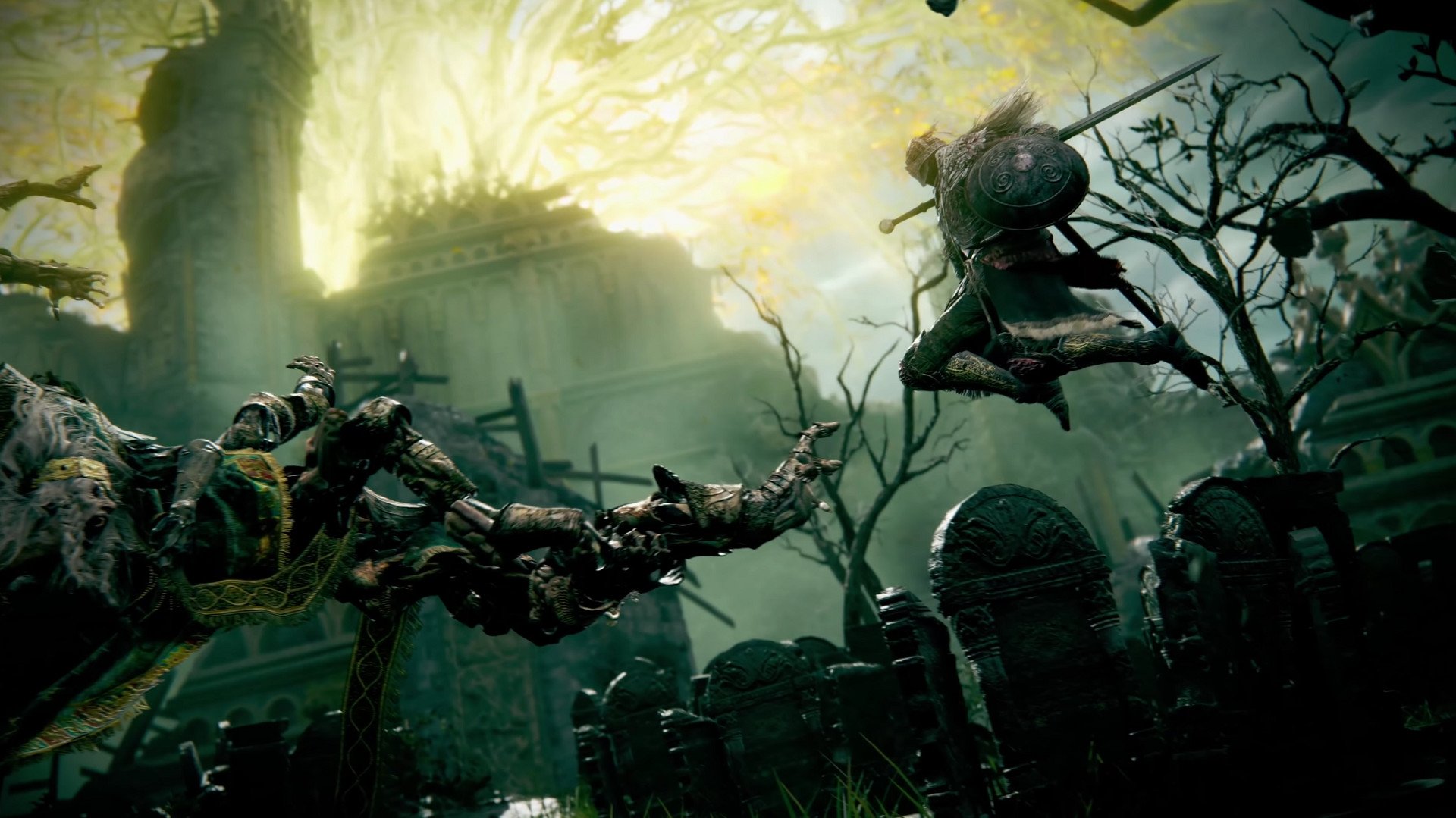
Melee combat in Elden Ring is central to the game. You can play as a wizard slinging spells or a bandit shooting arrows, but you will be forced into melee every now and then to play optimally. You’ll learn a ton through simply trial and error-ing your way through the game, but here are some crucial pointers to get to grips with the combat. Since resting at a Site of Grace respawns all nearby enemies, don’t feel shy to respawn enemies and practice on them to really learn the game.
- Holding Y / Triangle and then RB / R1 or LB / L1 respectively lets you swap your weapon to a two-handed status. This also works with shields, to my surprise.
- Two-handing those weapons lets you double their effectiveness, based on whatever stats they scale on. This can be crucial to defending and attacking certain enemies, in certain situations.
- If you press heavy attack (RT / R2) after a successful block, you will do a retaliatory riposte. This deals a higher rate of “stance damage” than a regular attack.
- Jumping heavy attacks, heavy attacks, and charged heavy attacks all also do higher rates of stance damage, which is a hidden value stat present on enemies.
- You can hold down practically any attack button to charge it, this puts a bit of extra stamina into it for a bit of extra damage. Use this carefully, since it can have unintended consequences and leave you stamina starved.
- Experiment with two-handed heavy attacks and switching around mid-battle. You can also attack with a shield while two-handing it.
- Remember that you don’t regen stamina while you’re holding down block. So it’s generally good practice to only block when you sense an incoming attack.
- Shields and other weapons have a mitigation rating, which you can view via the menu. The best shields provide 100% damage mitigation on a block, but the trade-off is usually their weight, which makes you move and roll slower if you pile on too much equipment load.
- Blocking with a shield, using melee attacks, and other physical actions drain stamina. Paying close attention to the green bar in the top left can be the difference between life and death, considering being hit while blocking without enough stamina will break your stance, leaving you stunned.
- If you deal enough stance damage using heavy attacks and ripostes, you can stance break an enemy, which essentially is a stun. From this stunned position, standing directly in front of an enemy and hitting LB / L1 light attack will score you a critical hit animation. This can devastate regular enemies and deal immense damage to bosses. Practice this maneuver as much as you can.
- You can also land this hit on regular humanoid enemies or enemies of a similar size to you via a backstab. Stealth and sneaking can help, but if you’re using light or medium rolls, you can position yourself behind enemies relatively easily, especially if they’re heavily armored.
- Knowing when to perform these types of attacks per enemy is part of Elden Ring’s “puzzle-like” combat. If you attempt to riposte at the start of an enemy’s combo, for example, you may get hit mid-attack.
- You’ll want to learn when an enemy’s animations have left them open to be hit with a riposte, heavy attack, or jumping attack.
- Enemies generally enter a “recovery period” after performing some attacks, which leaves them open to be hit.
- Some enemies are more susceptible to stance-breaking heavy attacks than others. You’ll just have to learn whether it’s worthwhile doing. More often than not, it is, though.
- Some enemies also have weak points, which are also often hidden. The most obvious weak point, generally, is an enemy’s head. Landing heavy attacks on the head will not only deal more damage, but also give a higher chance to create a stance break.
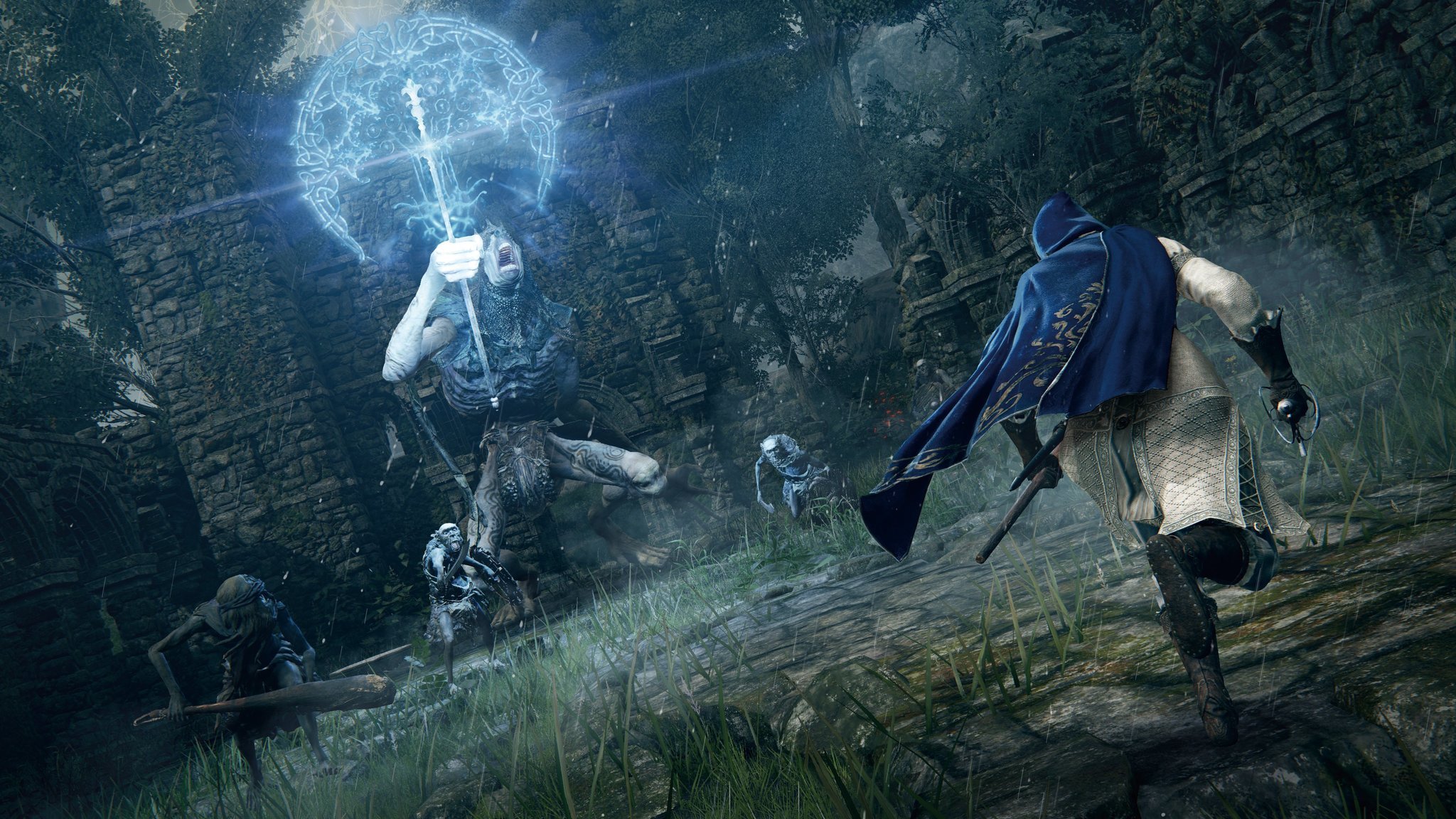
- The dragon in the starting area, for example, Agheel, is particularly susceptible to heavy attacks on his head. Once stunned, he’ll crash on the ground, giving you the opportunity to stab him in the eyeballs.
- While in the field, you can tap the left stick while running on your horse, you also do a jump, which can be used to create a heavy jumping attack. This is a high-risk maneuver though and leaves you horseless until you summon him again.
- Dodging gives you i-frames (invincibility frames), which help you remove all incoming damage from an enemy’s attack.
- Poise is an important stat to become familiar with as well. If you’re playing a light-armor dex-oriented bandit-style character, you’ll rely more on dodging to position yourself and mitigate damage. Your attacks will be fast enough that poise won’t matter too much. However, if you’re playing a heavily-armored warrior with a slow two-handed weapon, ensuring you have enough poise to ignore incoming light attacks mid-swing will ensure you can actually hit the enemy. A higher poise rating is essentially how much incoming damage you can take before you flinch. If you’re not dodging so much, having more poise facilitates slower weapons.
- Don’t get too attached to any single play style, ultimately. Some bosses may be easier to overcome if you strip off your armor to lower your equipment load to get faster dodge rolls, for example. That being said, be careful not to waste your Smithing Stones on several weapons. These items upgrade your melee gear, but they are also quite rare at the start of the game.
Trial and error is the way
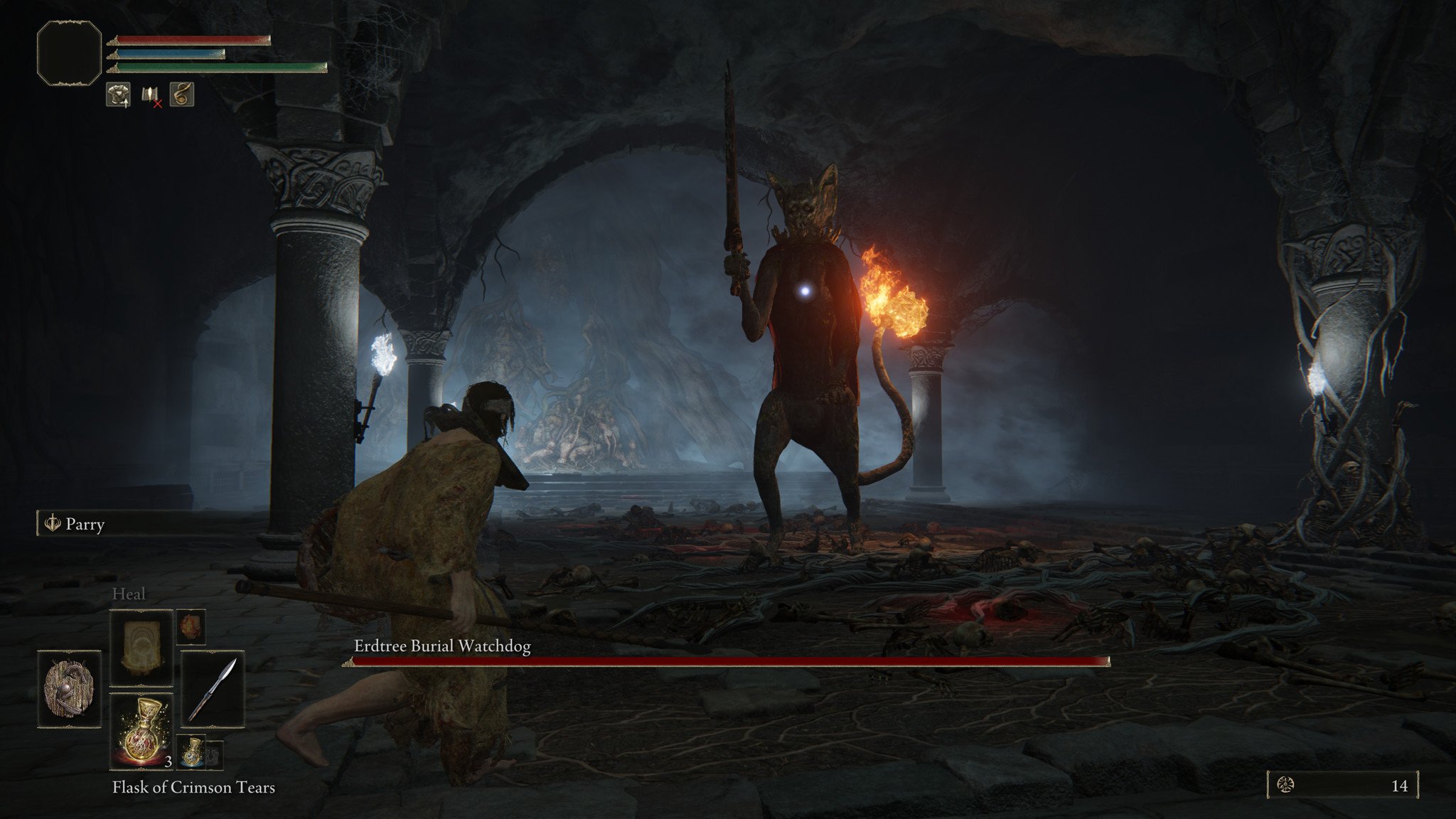
Ultimately, the best path forward is to practice. Grab the weapons you want to use, and mess around with the soldiers at the first outpost, North of Agheel Lake in the starting area. The soldiers there are good for practicing stealth attacks, backstabs, timing heavy attacks, practicing guarding, and so on. For this guide, I grabbed the Zweihander and messed around with it in different combinations to get a feel for how it all works.
Every weapon class has a unique set of moves, which can be further customized with the Ash of War skills. Learning the speed of the different attacks, then interweaving them to counter your enemies is crucial while committing it all to muscle memory in the process.
These tips are designed to help you get going, but they’re by no means the full range of depth represented in Elden Ring. If you feel overwhelmed by any particular situation or event in the game, it’s worth trying to get some advice from the community either on Elden Ring forums like Reddit, on YouTube, via our Discord.
We may earn a commission for purchases using our links. Learn more.

How to approach a Souls game like Elden Ring for absolute beginners
Elden Ring is quite tough, but it’s not unfair. If you’re finding yourself wishing you could get into these types of games, I’m here to tell you that you can, as someone who only did so relatively recently. I’m not a pro gamer by any means, yet I find myself enamored with Elden Ring’s magical world. You can be too.

New Windows 11 preview build brings improved taskbar for touch users
It’s time for another Windows 11 preview build, and this week is another big one. Today’s build is 22563 and features even more taskbar improvements, this time for tablet users. Microsoft is introducing a new auto-hide Taskbar interface that’s similar to the touch-first taskbar that was first introduced on Windows 10X and the Surface Neo.





